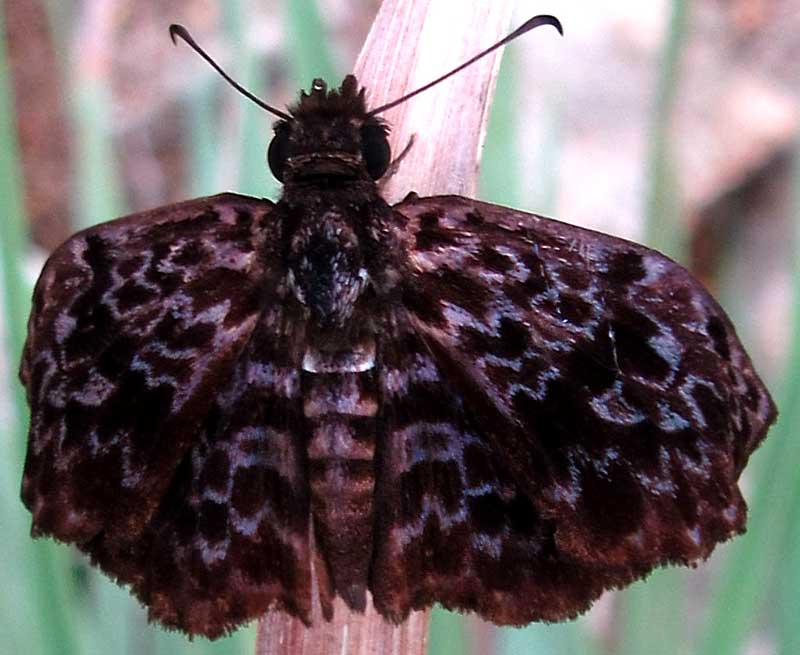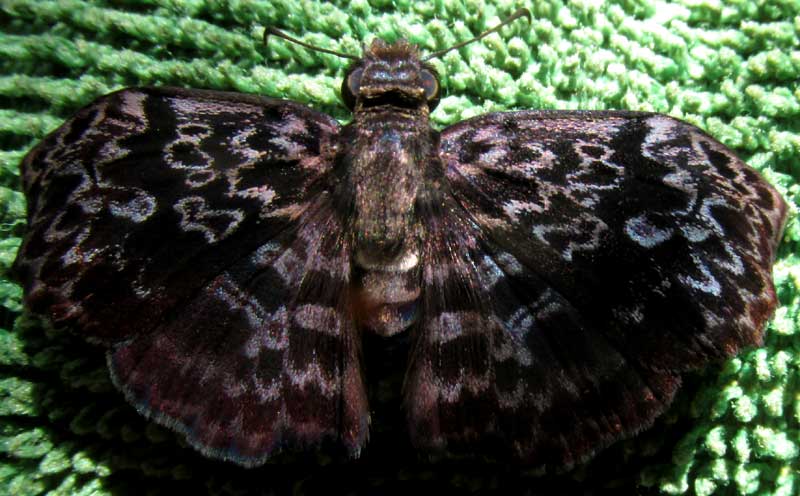Excerpts from Jim Conrad's
Naturalist Newsletter
from the March 6, 2016 Newsletter issued from Hacienda Chichen Resort beside Chichén Itzá Ruins; limestone bedrock; elevation ~39m (~128ft), N20.675°, W88.569°; central Yucatán state, MÉXICO
WIDESPREAD BENT-SKIPPER

While volunteer insect identifier Bea of Ontario was visiting she took many pictures she didn't have time to identify while here, so nowadays up in Ontario when she's not shoveling snow or negotiating icy roads, she's IDing her pictures. This week she figured out the name of the butterfly that of her discoveries I was most curious about, a dark little skipper whose wingtips drooped the way a bat's might, shown above in Bea's photo.
That's the Widespread Bent-Skipper, CYCLOGLYPHA THRASIBULUS ssp THRASIBULUS, distributed from Mexico south through Central America and northern South America to Peru. Occurring over such a large area, the species has fractured into various subspecies, and our subspecies is thrasibulus.
Many pictures of Widespread Bent-Skippers populate the Internet, but there's not much information about their life history. They're known to favor disturbed sites, such as forest edges, roadsides and forest trails, which accounts for their being fairly common. Males tend to bolt about zig-zagging and flying in tight circles just above the ground, and to gather at puddle edges sipping water rich in minerals, but I can't find information on the food eaten by its larvae.
It's unclear to me whether "Widespread" in the name means that the species is widespread, or that this species spreads its wings particularly wide. The hyphen in "Bent-Skipper" means that bent-skippers constitute their own formally recognized grouping -- a subfamily -- within the enormous Skipper Family. Butterfly fanciers refer to members of the bent-skippers' subfamily, the Pyrginae, as Flats or Spreadwings, of which about 990 species are known just in the Americas.
Why do basking bent-skippers fold down the tips of their forewings? I'm guessing that by doing so they create a slightly sheltered pocket of air beneath their dark, sunlight-absorbing bodies that warms during the basking process, helping the body warm up -- the greenhouse effect, but with a greenhouse whose walls are mostly missing.
The genus name Cycloglypha is nicely descriptive, cyclo meaning "circular,"and glypha referring to the "symbols" marking the wings -- "circular symbols."
from the July 20, 2018 Newsletter issued from Rancho Regenesis in the woods ±4kms west of Ek Balam Ruins; elevation ~40m (~130 ft), N~20.876°, W~88.170°; central Yucatán, MÉXICO
BENT-SKIPPER ON MY WASHRAG
The above entry provides an overhead view of the butterfly in which it isn't clear just how bent-down the wings are. This week a Widespread Bent-Skipper turned up on the hut's porch sipping moisture from the green washrag I'd just sponged the sweat from my body with. First, a top view of the visitor -- who enjoyed the washrag's mineral-rich moisture so thoroughly that he allowed me to get very close -- is shown below:

Now a view from the front, showing those bent-down wingtips, as well as the strawlike proboscis sucking up the good stuff, below:

I'm still curious about why various bent-skipper species develop bent wings. Earlier I mostly saw them basking in sunlight on coolish days, and I thought that maybe the bent wings kept warmth beneath their bodies, but now we're in a season where keeping warm is no problem and that idea loses its appeal.